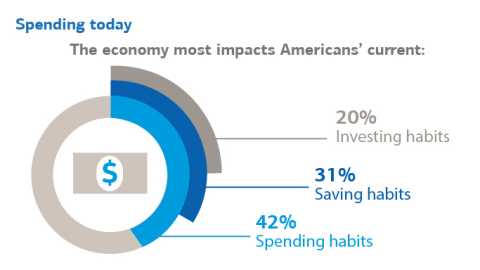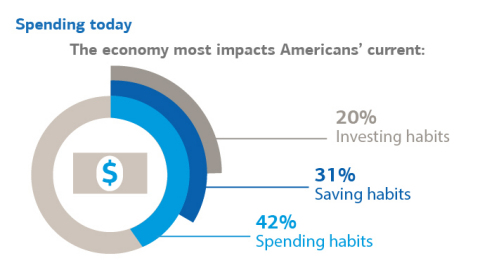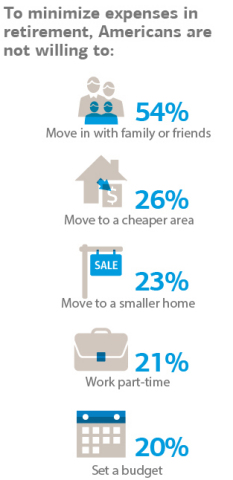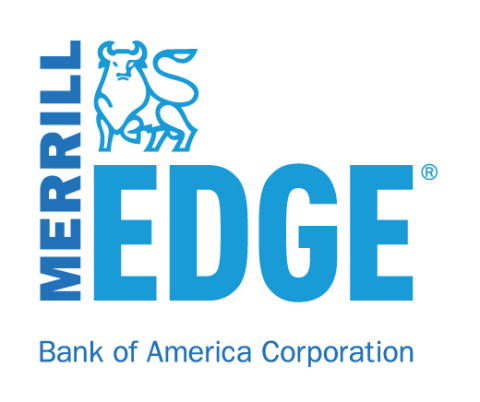NEW YORK--(BUSINESS WIRE)--A majority (59 percent) of Americans set a 2015 goal to save for retirement, but so far this year, less than one-third (31 percent) achieved that goal, according to a new survey released today by Bank of America and Merrill Edge.
The latest Merrill Edge® Report, a survey of more than 1,000 Americans with investable assets of $50,000 to $250,000, reveals that external economic pressures and debt they deem worthwhile, such as home or car debt, may be to blame for derailing financial goals, and that people with the most time to save seem to be the most impacted.
Nearly half (48 percent) of millennials report the economy most impacts their savings habits, as opposed to their spending or investing habits. So far this year, only 27 percent of millennials have been able to save for retirement. Previous Merrill Edge Reports found that younger generations were the most likely to anticipate a financially rocky retirement.
Overall, more than two in five (42 percent) Americans say the economy most impacts their spending habits. Many admit their finances could have been in better shape recently, with 36 percent of respondents saying they wish they had stuck more to a budget in the last five years. Only 38 percent have paid down debt thus far in 2015, despite more than half (51 percent) of Americans setting a goal to do so.
“Year over year, we continue to see financial regrets surrounding extraneous spending, particularly with the youngest generations, and it’s visibly impacting their ability to pursue long-term financial goals,” said Aron Levine, head of Merrill Edge at Bank of America. “The good news is we’re seeing increased optimism heading into 2016 with a focus on saving and investing, including a decrease in overall spending and an increasing reluctance to borrow from retirement funds.”
In looking towards 2016, the majority of respondents believe they will be saving more (68 percent), spending less (67 percent) and investing more (53 percent) throughout the year. Millennials differ from Gen Xers, baby boomers and seniors as they anticipate spending more (61 percent vs. 26 percent) as they save more (88 percent vs. 64 percent) and invest more (82 percent vs. 48 percent) in the coming year.
Saving toward a lifestyle upgrade in retirement
The biannual survey also found despite current economic pressures on their finances, the majority of Americans have high aspirations for their retirement years. Half (50 percent) of those who are saving for retirement want to upgrade their lifestyle in retirement, as opposed to just affording the basics.
Even though many non-retirees may have fallen short of 2015 financial goals, they recognize they are behind and are determined to address saving in the new year. Among those who are saving for retirement, a large majority (89 percent) are not comfortable putting off this task today, and nearly half (47 percent) regret not saving more for retirement in the last five years.
However, once they do reach retirement, many would not be willing to sacrifice their lifestyle to minimize expenses – specifically, moving in with loved ones (54 percent), moving to a cheaper area (26 percent), moving to a smaller home (23 percent), or setting a budget (20 percent). This mentality appears to align with current retirees’ financial attitudes and behaviors, including:
- Retirees say putting money away is less of a priority than non-retirees. Retirees believe that in 2016 they will invest less, not more (71 percent vs. 31 percent) and save less, not more (49 percent vs. 21 percent).
- Similarly, retirees are more apt than their non-retired counterparts (73 percent vs. 52 percent) to believe that a big purchase is worthwhile as long as it doesn’t put them in debt.
- Retirees are also notably less likely than those who are not retired to regret superfluous spending habits over the past five years, specifically wishing they had spent less on eating out (17 percent vs. 46 percent), clothing (10 percent vs. 28 percent), technology (8 percent vs. 20 percent), cars (7 percent vs. 17 percent) and vacations (5 percent vs. 19 percent).
Justifying debt to afford worthwhile purchases
Although many people are making concerted savings efforts to live a better lifestyle in retirement, the survey found that when looking back over the last five years, only 17 percent of respondents wish they only made purchases that they could afford. This may be due to the high value respondents see in large investments they deem to be worthwhile.
Although more than four in five (84 percent) respondents say they would not be comfortable making expensive purchases today, many say it could be worthwhile if it lasts a long time (57 percent), has more value in the future (42 percent) or creates lasting memories (27 percent). Perhaps due to their social sharing mentality, millennials are nearly three times as likely as other generations to justify a large expense if it generates lasting memories (61 percent vs. 21 percent); this generation is also most likely to see that a big expense is worthwhile if they feel it’s a once-in-a-lifetime opportunity (55 percent vs. 28 percent).
Additionally, the majority of those who incurred debt to pay for large expenses, such as their children’s education (91 percent), their own education (88 percent) and cars (80 percent), agree these particular financial obligations have been “worth it.”
Placing high value on real estate
This same sentiment is true as it relates to the home, as almost all (94 percent) Americans have no regrets about how much they spent on real estate in the past several years. Similarly, a majority of those who have gone into debt to pay for their homes (92 percent) and home improvements or renovations (74 percent) feel these debts were worthwhile. Most (66 percent) respondents also feel it was justified to go into debt to afford to move to a new area.
Yet, more than nine in 10 (96 percent) also admit they wouldn’t be comfortable living in a home that costs more than they can afford today.
“While some debt may make sense to take on, respondents need to be mindful that debt isn’t always an easy burden to manage,” said Levine. “Some of the top regrets of respondents this year included wishing they had paid off debt faster and avoiding going into debt altogether. So it’s important to keep your level of debt manageable to help balance spending with saving for retirement.”
For more in-depth information about the financial behaviors and priorities of mass affluent Americans, read the entire Fall 2015 Merrill Edge Report or take our poll here. A complementing infographic is available here.
Merrill Edge Survey Methodology
Braun Research, Inc. conducted a
nationally representative telephone survey on behalf of Merrill Edge.
The survey was conducted from September 8 through September 20, 2015,
and consisted of 1,001 mass affluent respondents throughout the U.S.,
defined as individuals with investable assets (value of all cash,
savings, mutual funds, CDs, IRAs, stock, bonds and all other types of
investments excluding primary home and other real estate investments).
Respondents in the study were defined as aged 18 to 34 (millennials)
with investable assets between $50,000 and $250,000 or those aged 18 to
34 who have investable assets between $20,000 and $50,000 with an annual
income of at least $50,000; or aged 35-plus with investable assets
between $50,000 and $250,000. We conducted an oversampling of 300 mass
affluents in the following markets: San Francisco; Los Angeles; Orange
County, California; Dallas; New Jersey; South Florida; Chicago; and
Phoenix. The markets of Chicago and Phoenix were newly surveyed this
wave. The margin of error is +/- 3.0 percent for the national sample and
about +/- 5.7 percent for the oversample markets, all reported at a 95
percent confidence level.
Merrill Edge
Merrill Edge is a streamlined investment service that
provides access to the investment insights of Merrill Lynch and the
convenience of Bank of America banking. With Merrill Edge, clients can
view their Merrill Edge investment and Bank of America bank accounts on
one page online. They also have access to easy-to-use tools, actionable
insights, one-on-one guidance and competitive pricing for online trades.
If clients prefer to receive advice and guidance to pursue and track
financial goals, Merrill Edge Roadmap® allows them to work one-on-one
with a Merrill Edge Financial Solutions Advisor to develop a
personalized action plan and receive specific investment recommendations
tailored to them and their personal goals.
Bank of America
Bank of America is one of the world's leading
financial institutions, serving individual consumers, small and
middle-market businesses and large corporations with a full range of
banking, investing, asset management and other financial and risk
management products and services. The company provides unmatched
convenience in the United States, serving approximately 47 million
consumer and small business relationships with approximately 4,700
retail financial centers, approximately 16,100 ATMs, and award-winning
online banking with 32 million active users and more than 18 million
mobile users. Bank of America is among the world's leading wealth
management companies and is a global leader in corporate and investment
banking and trading across a broad range of asset classes, serving
corporations, governments, institutions and individuals around the
world. Bank of America offers industry-leading support to approximately
3 million small business owners through a suite of innovative,
easy-to-use online products and services. The company serves clients
through operations in all 50 states, the District of Columbia, the U.S.
Virgin Islands, Puerto Rico and more than 35 countries. Bank of America
Corporation stock (NYSE: BAC) is listed on the New York Stock Exchange.
Visit the Bank of America newsroom for more Bank of America news.
Banking products are provided by Bank of America, N.A., and affiliated banks, Members FDIC and wholly owned subsidiaries of Bank of America Corporation.
Merrill Edge® is available through Merrill Lynch, Pierce, Fenner & Smith Incorporated (MLPF&S), and consists of the Merrill Edge Advisory Center (investment guidance) and self-directed online investing.
MLPF&S is a registered broker-dealer, Member SIPC and wholly owned subsidiary of Bank of America Corporation.
Investment products:
| Are Not FDIC Insured | Are Not Bank Guaranteed | May Lose Value |
© 2015 Bank of America Corporation. All rights reserved.





